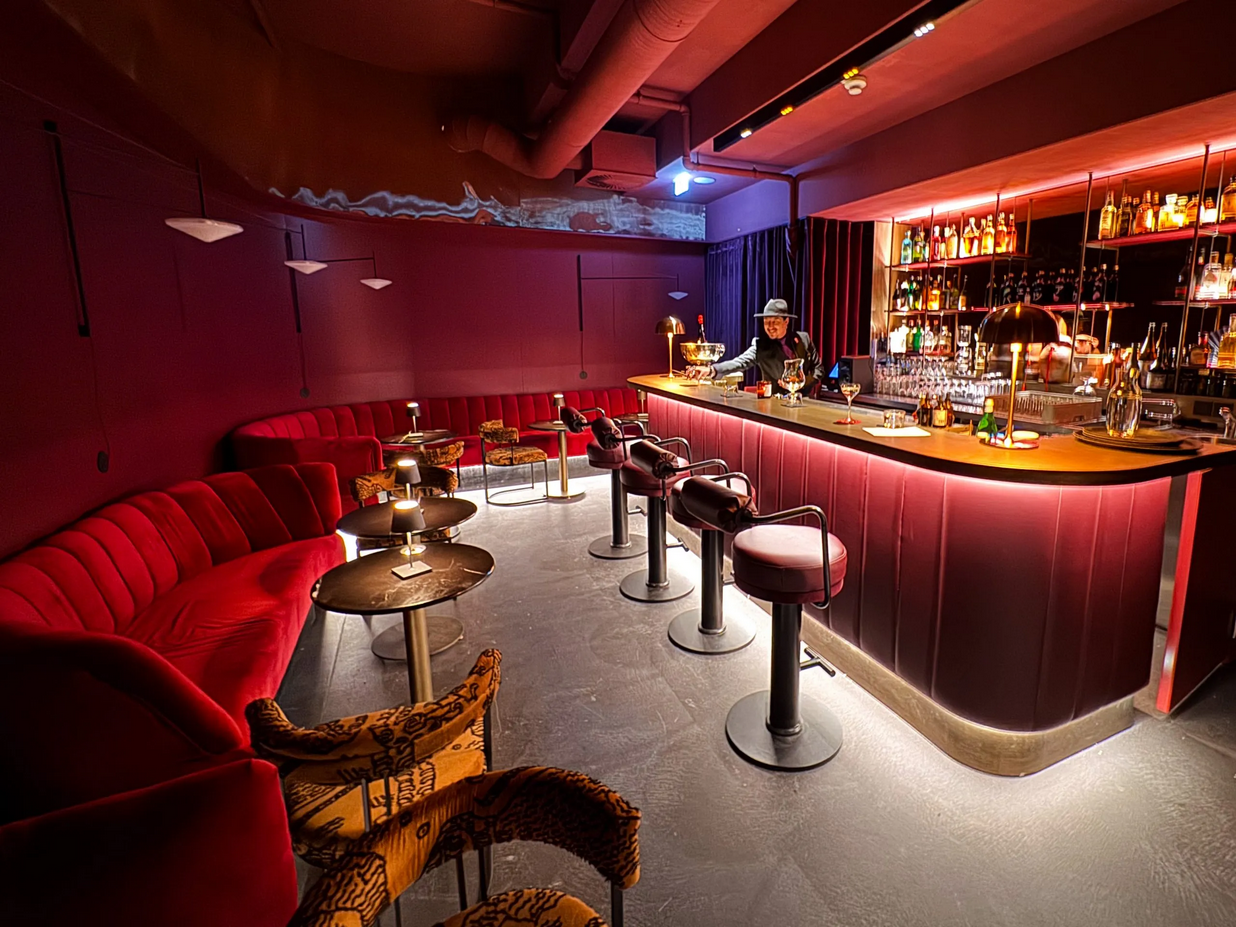#34 | Himitsu, Berlin, Germany
Last Visit: June 2024
In December of last year, a rather unusual bar opened in a rather unusual location on Berlin's Potsdamer Platz: Himitsu. After trying to approach the new bar concept as open-minded and uninformed as possible, to not get overly hyped as admirers of Japanese culture (John as well as myself), we were surprised by several moments and decisions in the bar. Why? That's what we're trying to find out in this article, because our visit is truly a little story of theory vs. practice, a strange atmosphere and a few question marks.
The photo above is actually one of the highlights when it comes to the visit for me. No, this is not a joke in the direction of “the highlight was the door out of the bar”, nor is it meant to be disrespectful towards the rest of the experience. The hidden entrance to Himitsu is simply a very clever idea and design. Light-colored wood, the Japanese culture & manga magazines as a reference, at the same time not too many obvious hints. As you may know, many bars these days calling themselves speakeasy are anything but actually speakeasy. Just a small red light at the top of the door and, above all, the fact that the bell is really hidden behind the sofa bench, and you have to slide your hand behind it: I appreciate that.
After ringing the bell, you are greeted and invited inside. Through a noren, a typical Japanese piece of fabric that separates rooms, you enter the bar. The first thing you notice here is something that has caused amusement in other cocktail temples too: The discrepancy between PR photos online and the impression on site. Himitsu is by no means the only case in this respect; even in my hometown of Cologne, I jokingly like to bring up the same examples again and again. The photo below shows quite well how it looks in reality: Relatively small (though not cramped) and reminiscent of a completely different kind of venue with the red velvet sofas. It also shows our biggest criticism when it comes to the atmosphere: Clearly too much light, even more so for a speakeasy vibe. Especially for the rest of the room, it was a problem; it was quite dark at the tables themselves. Due to these various factors, the whole bar also has a slightly shabby or at least outdated feel, despite the brand-new furnishings.
Copyright: Hidden Libations
The Himitsu has stirred up a lot of thoughts in us and me in particular, which relate to the bar landscape in general and current meta-topics in the industry. A short detour to the concept itself, for example. Speakeasy and Japanese seem to be the two keywords if you read other articles and reviews online. But wait, “Japanese”? When the Mixology article names the bar as such, the bartender intervenes, quote: “‘A Japanese-inspired bar’, corrects Aspra […]”. At first, I thought that maybe, as non-Japanese, they might not want to engage in cultural appropriation or something similar and would have respected that. But then again, their own Instagram profile says “Japanese speakeasy bar in Berlin” … So what is it, Japanese or Japanese-inspired? The back and forth is a little strange and certainly contributes to the fact that some visitors have quite different expectations.
Another example would be the staff. On the one hand, the service at the table was friendly, motivated, and open. On the other hand, they were very inexperienced when it came to telling stories and generally creating a certain service ambience. The fact that, despite the bar only being 1/3 full, the bartender preferred to talk a lot to people they apparently know from the industry instead of, for example, asking personally about our well-being or satisfaction (which for me would be a clear sign of Japanese hosting inspiration), certainly did not contribute to a special flair.
I certainly don't need any Michelin kind of service in a bar like Himitsu, but a tad more elegance and practice in the way of speaking and in bringing the concept closer to the guests would have been a little more immersive. I also don't quite understand why guests, who have obviously come to a still quite secret bar on the basis of articles and tips and above all only thanks to making a reservation (necessary here, which I actually approve of) and therefore need to understand the concept beforehand, have to be told again (and quite superficially) what “speakeasy” is. It's like explaining, without being asked, to every customer who goes into a McDonald's what a fast food restaurant actually is.
I could share one or two more thoughts, but let's get to the worst aspect, please click through the three pictures and pay attention to the table:
Our visit to Himitsu was the only bar visit in my memory where I actually felt a bit physically disgusted. On entering, I thought from a distance that the tables just had a slightly strange pattern. If you look at the marketing photos, you can indeed definitely see a slight marbling, which may also confuse the service in recognizing stains and dirt. But what you see in the photos above are dozens of stains from glasses, dirt and residue and none, really none of it was from our visit. As you can see, most of it already dried. The table next to us looked similar, although not quite as stained. How something like that can happen with only 20–25 seats, maybe 5 tables and the fact that the first thing you learn even in a pub is to wipe down the tables before each guest, is not entirely clear to me.
Kankitsurui
| Tio Pepe Sherry
| Bergamot
| Mancino Sakura Vermouth
| Umeshu
| Grapefruit Bitters
Himitsu's Negroni
| Japanese Gin
| Awamori
| Fernet Blend
| Vermouth Blend
| Yomogi Liqueur
| Campari Powder
You may have wondered why the menu was censored in a photo above, or why only two of the drink names are shown. Himitsu tries to keep a certain intimate flair, and therefore also asks guests not to photograph the menu. It's more about the specific ingredients in each drink, the cocktails themselves, and the bar can be photographed. We respect this, of course, and find it a valid and nice approach that fits in with the speakeasy theme, and the request is also conveyed very respectfully. That's why we're only sharing the two recipes that have already been fully published on their Instagram — fortunately the two better ones of the evening — and discuss all the drinks together.
The easy aperitif-style Kankitsurui gave me some hope to get started with. A pleasant, aromatic foam, for a fino-based drink nevertheless with an enjoyable body and quite a wealth of aromas, it came across as citrusy, floral and dry-silky. The combination of flavors is nothing new, but was implemented quite well here, Umeshu didn't really come through, but wasn't missed too much either.
The other drink — which I liked more than John — was the House Negroni. Awamori, also known as island sake, gives the Negroni template a lighter, silky body. The yomogi note was a little lacking in the taste and could have been a little stronger due to its herbaceousness and the otherwise lack of bite (for a Negroni). Without the Campari powder, the drink only worked halfway as a very light, smooth, round, Japanese-inspired Negroni. If you really take in the powder intensively while drinking, it definitely elevates the drink to a new level and left me satisfied. I missed the dry bitterness with a bit of pop before taking the powder with every sip, despite not being the biggest Negroni fan.
The other two drinks were not satisfactory for us and as we said, we don't want to name any ingredients, as requested by the bar. However, the sour-style drink was quite flat and not very complex, and the texture could have been better. The “stronger” drink in the tumbler, which was even supposed to boast umami notes, was similar to my Negroni. Without the powder, it landed on the very smooth (not the good “smooth”, the boring “smooth”) side. The umami, on the other hand, was almost nowhere to be found. A few cocktails here are also stored in Japanese clay pots. This is, of course, a bit of an “eye-catcher” in terms of the mental image conveyed, but you can taste less of it compared to other storage/aging methods and probably contributed even more to the very smooth end result. The selection of spirits is unsurprisingly relatively Japanese in character, but also the very least you should have if you want to use this topic as a flagship theme. Japanese liqueurs in particular stand out more distinctly and in there quantity and could certainly be used for some twists. The whisky selection and other categories such as sake or even shochu are rather minimal for a bar that upholds Japanese culture.
Copyright: Manifesto Market
I could go on about the “interesting” crowd that day and the decor and how much I had to think about criteria for bars in general, thanks to the Himitsu. As well as what would be really important in a review or, again, presumptuous to demand, etc. In retrospect, I was also interested in what other visitors I know, both professional bartenders and similarly interested bar nerds who I trust completely, had to say. I got some equally critical experiences, which made me feel a bit more at ease about our a bit troublesome visit. On the other hand, a well-known barfly blog wrote very favorably about the bar.
In fact, I can imagine that with the right mood when entering the bar, with a little less lighting inside on that day, with sitting directly at the bar instead of a table, as well as drinking only (for example) the two better (though not amazing) drinks mentioned, you can get and perhaps also enjoy an overall pleasant evening with a certain atmosphere not present in other Berlin bars. If the stars align just right, so to speak.
The more I thought about our visit, the more I realized that I actually left the bar less disappointed but rather confused and a little perplexed. There has to be a certain expectation for disappointment, and we had deliberately read absolutely nothing beforehand. The only thing that stayed in my head, but which I never took into the bar as a serious assessment, was the title of the Mixology article. After all, I only found out about the bar by searching for “Berlin” on their website for quick last-minute bar tips. “The high-end bar in the food court: Himitsu does away with clichés”. In everyday life, I'm often annoyed by the abundance of terms and words that are used inappropriately and in excess — “love”, “hate”, “of all time” or superlatives such as “the best”, “the coolest”, for every little ordinary thing. But with that headline, “high-end” has really lost all meaning.
Also: clichés are not really cleared up here, on the contrary, true and existing virtues of the Japanese bar scene are ignored. Which is all the more absurd when this culture is deliberately used as inspiration. Precision, elegance in service, craftsmanship, attention to detail. These are the first four virtues that come to mind when I think of Japan in hospitality in general and bars in particular. These we rarely found here, at least during our visit.
/rds












